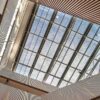DEFECTS IN BUILDINGS
Course Background
Building defects affect society at large due to possible danger posed; they also result in direct and indirect cost in repairs, abnormally high maintenance, disputes and possible loss of building use.
Defects are generally caused by inadequacies in design, poor workmanship, building usage not in accordance with design and lack of or incorrect maintenance. Dampness and Cracks are common manifestations of defects. Dampness can however often lead to Cracks, making it difficult to determine root cause and appropriate repair. Not all manifestations may be considered defects and not all defects are serious to the extent that it will affect building stability and occupant safety. Materials are often blamed for defects when the cause lies in the choice of unsuitable materials and/or when their limitations are recognised and taken into account in design and design detailing.
A new Dutch standard NEN 2767, believed to be a world-first in Building Condition Assessment attempts to provide insight and uniformity in defect assessment and classification, translating the diagnosis in condition scores. The standard is expected to contribute towards improving communications for all involved including litigations relating to defects.
Defects are generally caused by inadequacies in design, poor workmanship, building usage not in accordance with design and lack of or incorrect maintenance. Dampness and Cracks are common manifestations of defects. Dampness can however often lead to Cracks, making it difficult to determine root cause and appropriate repair. Not all manifestations may be considered defects and not all defects are serious to the extent that it will affect building stability and occupant safety. Materials are often blamed for defects when the cause lies in the choice of unsuitable materials and/or when their limitations are recognised and taken into account in design and design detailing.
A new Dutch standard NEN 2767, believed to be a world-first in Building Condition Assessment attempts to provide insight and uniformity in defect assessment and classification, translating the diagnosis in condition scores. The standard is expected to contribute towards improving communications for all involved including litigations relating to defects.
Course Objectives
The course will provide knowledge and insights in:
- Causes of Building Defects and Links in the Project Life Cycle
- Defects Assessment Standardisation and Defects Classification: NEN 2767
- Common Defects in Building Components and Diagnostics & Repair Methods
- Legal Aspects of Building Defects
Course Outline
- OVERVIEW OF DEFECTS IN BUILDING
- Common Causes of Defects
- Common Manifestation of Defects
- Design-Construction-Maintenance-Defects Link
- DEFECTS ASSESSMENT AND CLASSIFICATION: NEN 2767
- Defect Parameters: Type, Intensity & Extent of Defect
- Defect Classification: Minor, Serious & Critical Defects
- Defects-Condition Score
- COMMON BUILDING DEFECTS, DIAGNOSIS AND REPAIR METHODS
- Common Defects in:
- Structural Concrete Work
- Roofs
- Brickwork and Plaster
- Ceramic and Natural Stone Tiles
- Paint and Coatings
- Diagnosis and Defect Classification: Minor, Serious & Critical Defects
- Repair Methods
- LEGAL ASPECTS OF BUILDING DEFECTS
- Definition of Defects
- Developers: Claims Against Developers & Remedies Available
- Architects: Powers of Architect & Maintenance Certificate
- Claims Against Contractors & Consultants
- Damages for Defects
Who should take this course?
The course will benefit those who have a vested interest in buildings including:
- Developers
- Building Owners
- Government Officials
- Architects
- Engineers
- Project Managers
- Quantity Surveyors
- Contractors / Sub-Contractors / Suppliers
- Property Managers
- Facilities Managers
- Maintenance Managers
- Management Corporations
- Town Councils
- and Others
Course Accreditation and Certificate of Attendance
The course has been approved for 7 PDU units under the PE Board Continuing Professional Development programme. Attendance certificates will be issued; they may also be suitable for meeting the CPD requirements of other relevant professional bodies not operating a CPD course accreditation system.





